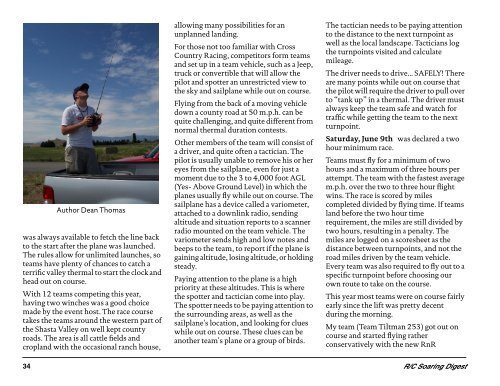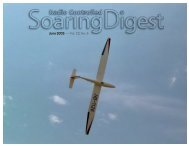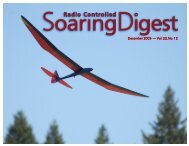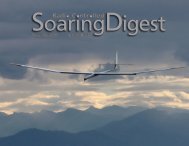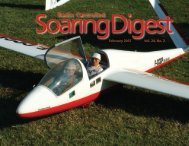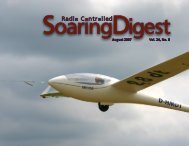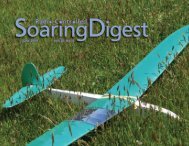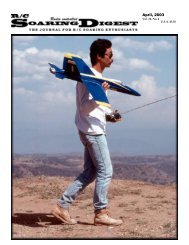August 2006 Vol. 23, No. 8 – R/C - RCSoaring.com
August 2006 Vol. 23, No. 8 – R/C - RCSoaring.com
August 2006 Vol. 23, No. 8 – R/C - RCSoaring.com
Create successful ePaper yourself
Turn your PDF publications into a flip-book with our unique Google optimized e-Paper software.
Author Dean Thomas<br />
was always available to fetch the line back<br />
to the start after the plane was launched.<br />
The rules allow for unlimited launches, so<br />
teams have plenty of chances to catch a<br />
terrific valley thermal to start the clock and<br />
head out on course.<br />
With 12 teams <strong>com</strong>peting this year,<br />
having two winches was a good choice<br />
made by the event host. The race course<br />
takes the teams around the western part of<br />
the Shasta Valley on well kept county<br />
roads. The area is all cattle fields and<br />
cropland with the occasional ranch house,<br />
allowing many possibilities for an<br />
unplanned landing.<br />
For those not too familiar with Cross<br />
Country Racing, <strong>com</strong>petitors form teams<br />
and set up in a team vehicle, such as a Jeep,<br />
truck or convertible that will allow the<br />
pilot and spotter an unrestricted view to<br />
the sky and sailplane while out on course.<br />
Flying from the back of a moving vehicle<br />
down a county road at 50 m.p.h. can be<br />
quite challenging, and quite different from<br />
normal thermal duration contests.<br />
Other members of the team will consist of<br />
a driver, and quite often a tactician. The<br />
pilot is usually unable to remove his or her<br />
eyes from the sailplane, even for just a<br />
moment due to the 3 to 4,000 foot AGL<br />
(Yes- Above Ground Level) in which the<br />
planes usually fly while out on course. The<br />
sailplane has a device called a variometer,<br />
attached to a downlink radio, sending<br />
altitude and situation reports to a scanner<br />
radio mounted on the team vehicle. The<br />
variometer sends high and low notes and<br />
beeps to the team, to report if the plane is<br />
gaining altitude, losing altitude, or holding<br />
steady.<br />
Paying attention to the plane is a high<br />
priority at these altitudes. This is where<br />
the spotter and tactician <strong>com</strong>e into play.<br />
The spotter needs to be paying attention to<br />
the surrounding areas, as well as the<br />
sailplane's location, and looking for clues<br />
while out on course. These clues can be<br />
another team's plane or a group of birds.<br />
The tactician needs to be paying attention<br />
to the distance to the next turnpoint as<br />
well as the local landscape. Tacticians log<br />
the turnpoints visited and calculate<br />
mileage.<br />
The driver needs to drive... SAFELY! There<br />
are many points while out on course that<br />
the pilot will require the driver to pull over<br />
to “tank up” in a thermal. The driver must<br />
always keep the team safe and watch for<br />
traffic while getting the team to the next<br />
turnpoint.<br />
Saturday, June 9th was declared a two<br />
hour minimum race.<br />
Teams must fly for a minimum of two<br />
hours and a maximum of three hours per<br />
attempt. The team with the fastest average<br />
m.p.h. over the two to three hour flight<br />
wins. The race is scored by miles<br />
<strong>com</strong>pleted divided by flying time. If teams<br />
land before the two hour time<br />
requirement, the miles are still divided by<br />
two hours, resulting in a penalty. The<br />
miles are logged on a scoresheet as the<br />
distance between turnpoints, and not the<br />
road miles driven by the team vehicle.<br />
Every team was also required to fly out to a<br />
specific turnpoint before choosing our<br />
own route to take on the course.<br />
This year most teams were on course fairly<br />
early since the lift was pretty decent<br />
during the morning.<br />
My team (Team Tiltman 253) got out on<br />
course and started flying rather<br />
conservatively with the new RnR<br />
34 R/C Soaring Digest


